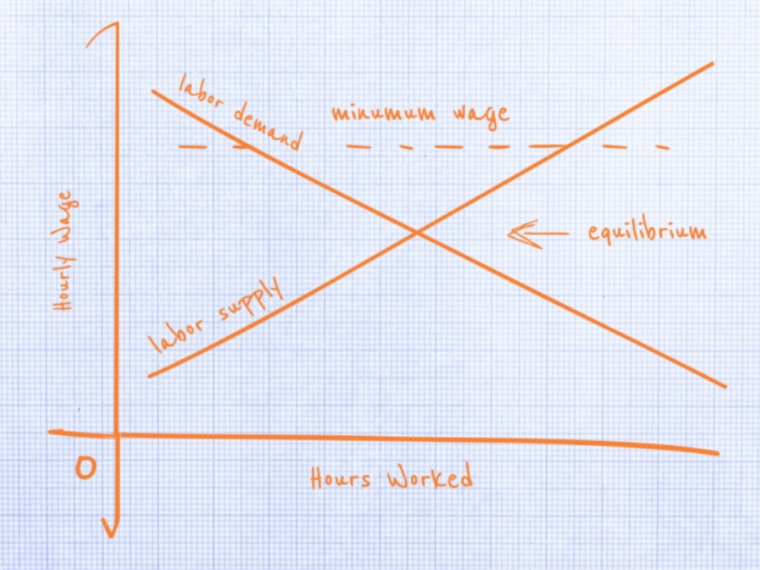Automation depresses career pay for many workers, notably including those in industries not automating
A working paper suggests we have grossly underestimated how many workers lose income when jobs are automated.
Automation, the study documents, has reduced the average amount of money workers can expect to earn in a multitude of careers, including those in industries with little or nothing automated. Especially in parts of the country with a lot of robots, expected wage growth slowed for low and high-skilled workers across hundreds of occupations. The study does not include generative AI in its analysis. But the researchers — Universitat Pompeu Fabra’s Maria Petrova, UCLA Anderson’s Gregor Schubert, SkyHive’s Bledi Taska and University of Pennsylvania’s Pinar Yildirim — expect AI will create the same societal and economic fallout they show with old-school automation: lower lifetime earnings across careers, due in large part to fewer opportunities for advancement.
“What’s changing here is not necessarily your current income,” Schubert explains in a phone interview. “It’s your trust in your future income that’s really being affected.” The research links automation to a decline in the kinds of jobs workers need to move up; missing rungs on career ladders that make even people with solid jobs grow pessimistic.
The work is a sweeping study of why achieving the American Dream — work hard, move up, prosper — seems harder today than it was for previous generations. The researchers offer new data on the declining numbers of job transitions workers are making throughout careers, and the smaller monetary gains realized with each move. The paper describes how automation in some industries affects workers employed in other fields. And it offers some evidence that worker reactions to this new reality can drag down the economy at large.
Sixteen Million Resumes
In the U.S., frequent opportunities to move from a low- to higher-income job are key to upward mobility. For example, the law firm junior associate makes associate, then moves to industry as corporate counsel and quite possibly on to top management. The biggest leaps in take-home pay come from such job hopping, not from raises you might earn for good work in your current job.
“So even though you’re right now working as a barista, there’s a very decent chance you’ll eventually go and find a white-collar job and make your way up the career ladder,” Schubert explains. And that leads to expected career earnings well above those of someone who spent a lifetime as a barista.
By several measures, many Americans today struggle to find these paths to higher standards of living. The fraction of 30-year-olds who earn more than their parents did at that age has generally been in decline since the 1940s, according to a 2016 study published in Science. The share of U.S. wealth going to low- and middle-wage earners is about as low as it’s ever been.
Petrova, Schubert, Taska and Yildirim begin by looking for trends in job mobility. They culled some 16 million resumes from workers who changed jobs at least once between 2000 and 2016. The sample came from Burning Glass Technologies, a data source that scrapes resumes from some 3,000 internet jobs platforms such as LinkedIn and Monster.com.
The researchers used the job trajectories seen in these resumes — the previous job changes each candidate listed — to map common career paths for roughly 650 occupations in each of those years. They witnessed, for example, that construction workers often move up into management positions or over to the more lucrative transportation or engineering industries. It’s not uncommon for a waiter to take an entry-level white-collar job in another industry (personal assistant or call center representative, for example) and for some even to get on track for a management position.
Fewer Move Up, More Move Down
The researchers then assigned a “career value” to each occupation. The value represents the average amount of money workers earn over their entire careers by starting in a particular occupation, in a particular region, and making those common job changes along the way. An occupation’s career value varies by location (commuting zone), because the researchers took into account differences in pay scales around the country.
The study shows that workers across industries changed jobs less frequently between 2004 and 2016 than in previous years. Moreover, fewer of those moves resulted in more pay, according to the study. More of them resulted in a pay cut.
The study suggests that workers in hundreds of occupations that began their careers after 2004 are unlikely to earn as much (inflation-adjusted) money over their lifetimes as the people who started the same career earlier in the decade.
Not all career paths suffered. For example, career pay jumped exceptionally high for people who started out in management. Health care and engineering careers became significantly more lucrative. Careers originating from food service paid more.
But lifetime earnings for lawyers, maintenance and production workers and many others took a nosedive. Overall, the total declines in wage growth outstripped the gains.
Stuck in Construction
The researchers attribute about two-thirds of the average career value decline to lower wage gains — wages generally didn’t rise as quickly in those later years as they had before. They track about a third of the overall decline to fewer moves to higher paying occupations in the later years.
In 2004, for example, construction workers often advanced by moving from trade work into management positions or over to jobs in architecture or engineering industries. By 2015, it was much less common for a construction worker to make these moves.
Automation and Broken Career Ladders
While data on job transitions helps explain the decline in lifetime wages, it doesn’t uncover the forces that broke those career ladders. To assess automation as a potential factor, the authors compared a variety of careers in parts of the country that are home to a lot of robots with careers in places with fewer robots. The International Federation of Robotics, an organization that keeps track of operational robots in 38 industries and about 50 countries, was a key source of data.
The data here suggest that even one robot per 1,000 workers can uproot careers that had nothing to do with the automated job. In local economies with a lot of automation, wages declined in retail wholesale trade, health care, construction, and professional and technical services. Keep in mind that high manufacturing parts of the country employ a lot more robots than one robot per 1,000 workers.
Across the nation, there was a 6.2% decrease, during the years of the study period, in moves to jobs with better pay, and a 5.9% increase in moves to lower pay. Transitioning into jobs with similar pay remained about the same. In high manufacturing commuting zones, the negative effects were magnified. Transitions to higher-pay jobs declined 6.3%, and transitions to lower paying jobs increased 10.2%. Job moves with little or no pay change increased 16.9%. The likelihood of ever transitioning into a management role declined.
From the resumes, the researchers could see that layoffs of people directly affected by automation could not be the sole cause of the trend. Instead, they observed, fewer workers were making the kind of midcareer job changes that, in the past, benefited people who started in the same jobs. Without those interim moves, workers couldn’t get to the same level of lifetime earnings they once expected.
“In order to get to some high-paying jobs, you normally have to get some medium-paying jobs first,” Schubert says. “If you never make it into the job (for example) of being a software programmer, you’re not likely to ever become the software programming manager.”
A Welder, a Robot and the Entire Economy
This study tackles issues around upward mobility from a variety of angles. After job mobility and automation, the researchers looked at how housing and education choices, consumption and political ideals might be affected by declining career values.
This wide approach, however, helps paint a picture of how individual workers’ fortunes, and the economy writ large, might evolve amid increasing automation, whether by robots or computer code.
The study upends the comforting narrative around automation: Though it leaves some workers unemployed, as robots or other automation move in to do jobs faster and more efficiently than humanly possible, resulting cost reductions and productivity gains spread through the economy, creating even more jobs. The immediate displacement of some workers, in this narrative, is considered necessary collateral damage for such progress. Re-training is offered to the displaced (though it often isn’t successful in re-slotting careers).
Based on the paper, here’s an updated, if somewhat simplified, narrative:
Say a local machine parts factory installs robots to take over the welding steps on its assembly line. The human welders there are now out of work. The less skilled line workers are still needed, but any plans they had to train for the better-paying welding jobs are now off the table.
The welder, along with ambitious line workers, goes looking for new jobs. Maybe the welder goes to work at a construction site for similar, or even better, pay. The assembly line worker with less education and skill is more likely to take a pay cut or make a sideways move. He might get a job at a less automated factory or maybe get other low-paying work, perhaps as a janitor or a security guard, in any number of industries.
As more and more robots move into nearby manufacturing, workers in occupations unrelated to automation start getting squeezed. With the influx of job applicants from worried and displaced factory workers, employers not involved in automation are less compelled to raise wages. The newcomers compete for promotions the insiders had expected to get. Workers in these seemingly “safe” industries start lowering expectations about their own career earnings in much the same way as the welders who literally lost their jobs to robots.
Swap out welders for data analysts, and we get a similar scenario when companies automate with AI. The human data analysts are losing jobs as hospitals, financial institutions and other good-paying employers adopt AI for the work. While a data entry clerk may still be needed, her most likely path to career advancement is no longer viable. She can’t just skip the data analyst experience and expect to move even further up into management, in part because the skill set for the job has radically changed. To get the pay raises she once expected, she most likely has to join the data analysts on the now limited job market or take courses that will put her on a path to get another job that leads to management.
More optimistic scenarios for the impact of AI are also possible as the technology may lead to the creation of new positions and career paths that could previously not be envisioned. In any case, this paper highlights that thinking about workers’ career paths into these new opportunities is important for understanding the AI boom’s ripple effects in the labor market.
Not Their Fathers’ Economy
The study may help explain why so many Americans are screaming for economic improvement, even though today’s economy is, by many aggregate measures, stronger than it’s been in decades. It’s not just the welders who actually lose their jobs to robots who are feeling disaffected, according to this study. It’s thousands of other workers watching their own career prospects dim. Both groups tend to respond more darkly in Gallup polls on questions about the economy.
They cut their spending on groceries and household goods, the study suggests, and possibly much more. Demand for new housing in their commuting zones declines. Overall local consumption falls alongside overall career values, especially in places with a lot of automation. Local retailers and service providers are among those that lose business.
Finally, the study shows that those affected even indirectly by this decline were more likely to look to populist political leadership for answers. More robots and lower career values correlated with more votes for Donald Trump in 2016. (The researchers counted Trump voters because he was then the most populist of the main candidates. Very liberal politicians, like Bernie Sanders, are also considered populist candidates.)
The trends in the study point to a future in which more workers spend lifetimes in very low-paying jobs. A partial antidote might be more education. The researchers show that in areas where education levels are high, career values remain stronger amid automation. Fewer negative consequences ensue.
Of course, we presume that retraining workers displaced by automation is the best way to get them back to stable earnings. But we’re barely touching the problem with that limited approach, the authors suggest. “It is essential to think about the effects of automation from a broader perspective — focusing on industries beyond those that are most immediately impacted and beyond the immediate occupation of workers,” they write. Looks like a lot more people than those welders could use the help.
Featured Faculty
-
Gregor Schubert
Assistant Professor of Finance
About the Research
Petrova, M., Schubert, G., Taska, B., & Yildirim, P. (2024) Automation, Career Values, and Political Preferences. Available at SSRN 4728005.
Chetty, R., Grusky, D., Hell, M., Hendren, N., Manduca, R., & Narang, J. (2017). The fading American dream: Trends in absolute income mobility since 1940. Science, 356(6336), 398–406.




